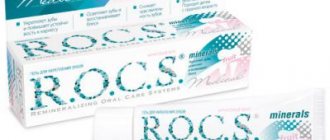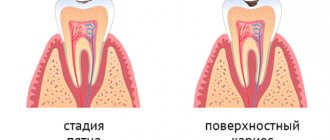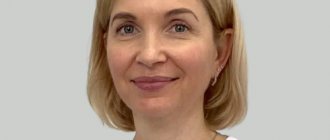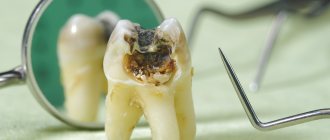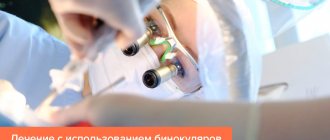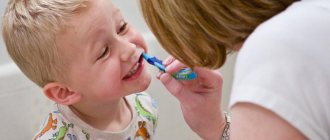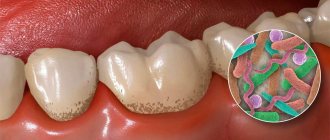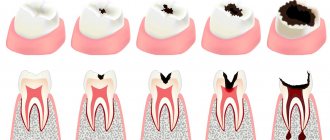The most important area of dentistry is the prevention of dental caries.
It is necessary for children, teenagers and adults.
After all, routine prevention of dental caries is the shortest path to a healthy smile, for which there are now available means and effective methods.
According to the methods of influence, the prevention of dental caries differs into primary and secondary.
But in general, it represents a set of measures to prevent the occurrence of diseases, their relapses and complications. It begins with a visit to the dentist, which is necessary at least every six months.
Methods for preventing caries
Conventionally, methods of caries prevention can be divided into household and professional. Household methods include time-tested and proven methods that are passed down from generation to generation. They do not require any energy expenditure, but they do need regularity. Professional prevention includes various hygiene procedures and timely treatment of caries. They also distinguish endogenous prevention, which is aimed at strengthening teeth from the inside, and exogenous, when all actions are carried out locally. So how can you stop dental caries?
Personal oral hygiene as protection against caries
Individual oral hygiene plays an important role in preventing caries. It refers to exogenous non-drug methods of prevention.
Regular brushing of teeth, tongue, removal of food debris, soft deposits contributes to the proper development and functioning of tooth enamel. The components of therapeutic and prophylactic pastes enrich the tissues of the oral cavity with calcium and phosphate salts, vitamins and microelements, making them more resistant to negative influences. Massaging the gums with a toothbrush activates metabolism, improves blood circulation in periodontal tissues, and prevents bleeding and gum disease.
Personal hygiene involves careful independent removal of plaque from the surface of teeth and gums using toothbrushes, pastes and other products.
The effectiveness of individual oral hygiene depends on several factors:
- quality and compliance of the characteristics of the toothbrush with the condition of the teeth of a particular patient;
- following proper cleaning techniques;
- the use of additional cleansing methods - irrigators, dental floss, mono-beam and orthodontic brushes, rinses.
Primary or endogenous prevention of caries
Proper nutrition is important in preventing tooth decay. This is not only about giving up chocolate and cakes, but also soda and concentrated juices. You should not eat sour apples, as they disrupt the acidity of saliva. It is better to replace them with hard, raw carrots, which clean your teeth almost better than a good specialized paste. It wouldn’t be a bad idea to nibble on Japanese horseradish – wasabi – from time to time. Japanese scientists have found that it blocks the growth of carious microbes.
Paradoxically, kissing is a great way to defeat tooth decay. When we kiss, the gums are massaged and salivation becomes more intense, and along with it, the acid-base balance is evened out.
If you have a tendency to develop caries, it makes sense to consult a specialist for recommendations on taking vitamins. Russian scientists have found that the demineralization of enamel is affected by a deficiency of vitamin C. During the experiment, it was found that those who were attacked by caries had a decrease in its content in the body several months before. In addition, vitamin D also increases the resistance of teeth to caries, since calcium is easily absorbed with it. Don't forget about such a useful element as fluorine. It has a pronounced anti-caries effect.
Nutrition rules
Doctors recommend limiting the consumption of sweets, replacing carbonated drinks with compote, and confectionery with dried fruits. After each meal you should rinse your mouth thoroughly.
A balanced diet must include:
- fermented milk products;
- nuts;
- fresh herbs;
- cheese;
- dietary fish varieties with low fat content;
- meat.
It is better to refrain from eating too cold or hot foods or drinks. Alternating temperatures negatively affects enamel. As a result, cracks appear, which promotes the growth of bacteria.
Secondary or exogenous prevention of caries
As already mentioned, exogenous prevention is characterized by a local effect on the teeth. Good cleaning should occur at least twice a day using dental floss and an antibacterial mouth rinse. If you are the owner of dentures, then you cannot do without using an irrigator. You need to brush your teeth for at least 4 to 5 minutes.
How to brush your teeth properly to prevent tooth decay:
- The method of brushing your teeth should combine horizontal, vertical and circular movements.
- Brush movements should be short and circular. Make sure that the long bristles remove plaque from under the gum line and between the teeth.
- The head of the toothbrush should be at an angle of 45°.
- Brushing your teeth should take at least 5 minutes.
- It’s not just your teeth that you need to brush – plaque on your tongue is just as much a breeding ground for germs as dental plaque.
How to reduce the adverse effects of carbohydrates on teeth
Fermentation of carbohydrates under the influence of microbes leads to the production of organic acid, which destroys tooth enamel and contributes to the development of caries. It is impossible to completely stop eating carbohydrates, but it is quite possible to reduce the intensity of their influence on the development of caries. The following measures will help with this:
- Reducing the amount and, most importantly, the frequency of eating carbohydrate foods, so that the teeth come into contact with carbohydrates as little as possible.
- In some cases, your doctor may recommend switching from sugar to sweetener substitutes.
- Reducing the time carbohydrates spend in the mouth. This can be achieved in two ways: do not eat the sweet dish last, and be sure to rinse your mouth after eating.
- Avoid eating sweets at night and between meals.
If any of the recommendations are violated, to reduce the risk of caries, you need to brush your teeth and rinse your mouth.
Products for the prevention of dental caries
Toothpaste against caries, or anti-caries, helps strengthen mineral dental tissues and prevents the formation of plaque due to the fluorine, phosphorus and calcium compounds introduced into the composition. The anti-carious effect of toothpastes is explained by the fact that topically applied fluorides increase the resistance of enamel to adverse effects. Penetrating into the enamel structure, fluorine creates a more durable fluorapatite system, fixes phosphorus-calcium compounds in hard dental tissues, and also suppresses the growth of soft plaque microflora. Anti-caries paste is most active during the period of enamel maturation, and later its effectiveness decreases significantly. Therefore, it is most reasonable to use anti-caries toothpastes in childhood to prevent caries in children.
Unlike toothpaste, a toothbrush can significantly improve or, if chosen incorrectly, worsen your oral health. For example, regular manual brushes with stiff bristles are not suitable for people with problem gums. Such brushing will only increase the colony of harmful bacteria and increase gum bleeding. The same can be said about electric toothbrushes, which also drive plaque under the gums, which leads to a serious inflammatory process. Today, the most effective way to prevent caries is to purchase a brush with ultrasound, which not only gets rid of plaque, but also destroys harmful microorganisms.
Why does caries occur?
During the process of eating food, its smallest particles are retained on the surface of the tooth enamel. Along with them, various bacteria (microorganisms several micrometers in size) remain. It is worth noting that bacteria are everywhere, but only some of them, under certain conditions, can harm human health. Having attached to the enamel layer, the bacteria secrete dextrins (a sticky substance), gradually forming dental plaque and creating conditions for comfortable life. During this process, microorganisms produce lactic acid, which begins to corrode the enamel. As a result, microcracks form at the site of plaque attachment. This is the initial stage of caries. If the plaque is not removed in a timely manner, the destruction progresses. As a result, the enamel is destroyed (superficial caries), and dentin tissue is involved in the pathological process (medium and deep caries).
Modern prevention of caries
While strictly following all the rules of oral hygiene, do not forget to visit the dental office twice a year. No matter how hard we try to brush our teeth thoroughly and regularly, it is still not enough. Only professional hygienic cleaning can completely remove plaque and get rid of tartar. In addition, as a local prevention of caries, the hygienist performs a dental remineralization procedure. It allows you to restore the mineral composition of dental tissue and increase its resistance to caries. Typically, this procedure is part of professional hygiene and is recommended before and after teeth whitening at home or in the dentist's office.
It is especially important to seal teeth in time to prevent dental caries. Since 1984, in the USA, and later in our country, sealants have been used that delay the development of caries by closing the fissures and blind pits of the tooth. The procedure for sealing fissures is completely painless and is usually carried out in childhood and adolescence.
Correcting malocclusion and crooked teeth is one of the important components of professional caries prevention in adults and children. It has been proven that malocclusion and crowding of teeth, uneven load on them provokes the carious process and creates favorable conditions for its development.
The most effective and at the same time simplest way to prevent dental diseases is proper and regular dental and oral hygiene. By following simple, but systematic, rules, you can avoid many troubles with your teeth. But do not forget that caries is an internal signal of a failure of the body as a whole. As they say, healthy teeth in a healthy body!
Preventive examinations
Regular visits to the dentist will help prevent tooth decay or detect its presence at an early stage. Professional teeth cleaning is recommended 2-3 times a year. These procedures can be combined with examinations, which should be carried out at the same frequency. If there are no complaints, it is enough to visit a hygienist.
Only a specialist using professional tools can detect the disease at an early stage. As a rule, it appears as a white spot. Sometimes small dark dots appear. If the putrefactive process has affected the lateral groups of the dentition, then it is impossible to notice it on your own. Blind spots also include the inner surfaces of the incisors.
Patients usually discover caries when it is in an advanced form and a small cavity has already appeared. One of the signs of a problem is also increased sensitivity. If your gums begin to bleed, there are obvious discolorations on the enamel and pain, then it is advisable not to wait for a scheduled examination, but to immediately visit a doctor.
Clinical researches
ASEPTA toothpastes are clinically proven effective. For example, clinical studies have proven that regular use of professional toothpaste ASEPTA REMINERALIZATION improved the condition of the enamel by 64% and reduced tooth sensitivity by 66% after just 4 weeks.
In addition, clinical studies have proven that regular use of preventive toothpaste ASEPTA ACTIVE for a month can reduce bleeding gums by 60%, improve the overall condition of the oral cavity by 44% and reduce inflammation by 33%.
Sources:
- Report on determining/confirming the preventive properties of toothpaste “ASEPTA PLUS” GENTLE WHITENING” Author: doctor-researcher A.A. Leontyev, head Department of Preventive Dentistry, Doctor of Medical Sciences, Professor S.B. Ulitovsky First St. Petersburg State Medical University named after. acad. I.P. Pavlova, Department of Preventive Dentistry
- Clinical and laboratory assessment of the influence of domestic therapeutic and prophylactic toothpaste based on plant extracts on the condition of the oral cavity in patients with simple marginal gingivitis. Doctor of Medical Sciences, Professor Elovikova T.M.1, Candidate of Chemical Sciences, Associate Professor Ermishina E.Yu. 2, Doctor of Technical Sciences Associate Professor Belokonova N.A. 2 Department of Therapeutic Dentistry USMU1, Department of General Chemistry USMU2
- Report on the determination/confirmation of the preventive properties of personal oral hygiene products “ASEPTA PLUS” Remineralization doctor-researcher A.A. Leontyev, head Department of Preventive Dentistry, Doctor of Medical Sciences, Professor S.B. Ulitovsky First St. Petersburg State Medical University named after. acad. I.P. Pavlova, Department of Preventive Dentistry
- Clinical studies of antisensitive toothpaste “Asepta Sensitive” (A.A. Leontyev, O.V. Kalinina, S.B. Ulitovsky) A.A. LEONTIEV, dentist O.V. KALININA, dentist S.B. ULITOVSKY, Doctor of Medical Sciences, Prof. Department of Therapeutic Dentistry, St. Petersburg State Medical University named after. acad. I.P. Pavlova
- The role of anti-inflammatory rinse in the treatment of periodontal diseases (L.Yu. Orekhova, A.A. Leontyev, S.B. Ulitovsky) L.Yu. OREKHOVA, Doctor of Medical Sciences, Prof., Head of Department; A.A. LEONTIEV, dentist; S.B. ULITOVSKY, Doctor of Medical Sciences, Prof. Department of Therapeutic Dentistry of St. Petersburg State Medical University named after. acad. I. P. Pavlova
- Report on determining/confirming the preventive properties of toothpaste “ASEPTA PLUS” COFFEE and TOBACCO Author: doctor-researcher A.A. Leontyev, head Department of Preventive Dentistry, Doctor of Medical Sciences, Professor S.B. Ulitovsky. First St. Petersburg State Medical University named after. acad. I.P. Pavlova, Department of Preventive Dentistry
- Report on determining/confirming the preventive properties of commercially produced personal oral hygiene products: Asepta toothpaste used in combination with Asepta mouthwash and Asepta gum balm Head. Department of PFS Doctor of Medical Sciences Professor S.B. Ulitovsky St. Petersburg State Medical University named after Academician I.P. Pavlova. Faculty of Dentistry. Department of Preventive Dentistry.
Do I need a dental scan?
American dentists recommend having your teeth x-rayed every year. Austin Frakt, a health economist, reviewed[] medical studies and concluded that such reinsurance is unwarranted. Cavities in the tooth form more slowly—over 2–3 years.
In Russia, preventive x-rays are not so popular. But computed tomography is suggested to be done regularly. You should also not agree to this expensive service more often than once every couple of years.
Which toothpaste is more effective?
The good news is that brushing your teeth is still beneficial. But to prevent the development of caries, the paste must contain fluoride. A study of the results of dental examinations of children aged 5 to 16 years []confirmed the effectiveness of the use of this mineral for the prevention of caries and tooth loss. Moreover, it is better to brush your teeth with fluoride paste twice, not once: the positive effect will be more noticeable.
True, fluoride paste does not help against gingivitis and plaque on teeth. But it really protects against enamel destruction.
How to stop tooth decay: correcting your bite
According to many, malocclusion is a minor cosmetic defect that does not have a major impact on dental health. In some cases this may be true; However, malocclusion can also cause uneven distribution of stress on the teeth during chewing, which, in turn, leads to premature wear. Without time to recover from mechanical stress, the enamel becomes much more susceptible to the effects of other destructive factors, which ultimately can lead to the onset of the carious process.
That is why bite correction should also be included in the list of preventive procedures. To correct it today, a wide range of technologies and methods are used - from installing braces to surgical intervention.

